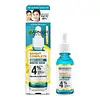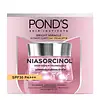What's inside
What's inside
 Key Ingredients
Key Ingredients

 Benefits
Benefits

 Concerns
Concerns

 Ingredients Side-by-side
Ingredients Side-by-side

Water
Skin ConditioningAlcohol Denat.
AntimicrobialNiacinamide
SmoothingGlycerin
HumectantPropanediol
SolventLinalool
PerfumingGeraniol
PerfumingSodium Hydroxide
BufferingSalicylic Acid
MaskingAscorbyl Glucoside
AntioxidantLimonene
PerfumingHydroxypropyl Guar
Emulsion StabilisingHydroxyacetophenone
AntioxidantHydroxyethylpiperazine Ethane Sulfonic Acid
BufferingCitrus Limon Fruit Extract
MaskingLactic Acid
BufferingPhytic Acid
Benzyl Salicylate
PerfumingBenzyl Alcohol
PerfumingPEG-60 Hydrogenated Castor Oil
EmulsifyingParfum
MaskingWater, Alcohol Denat., Niacinamide, Glycerin, Propanediol, Linalool, Geraniol, Sodium Hydroxide, Salicylic Acid, Ascorbyl Glucoside, Limonene, Hydroxypropyl Guar, Hydroxyacetophenone, Hydroxyethylpiperazine Ethane Sulfonic Acid, Citrus Limon Fruit Extract, Lactic Acid, Phytic Acid, Benzyl Salicylate, Benzyl Alcohol, PEG-60 Hydrogenated Castor Oil, Parfum
Water
Skin ConditioningOctocrylene
UV AbsorberEthylhexyl Salicylate
UV AbsorberStearic Acid
CleansingNiacinamide
SmoothingGlyceryl Stearate
EmollientButyl Methoxydibenzoylmethane
UV AbsorberEthylhexyl Methoxycinnamate
UV AbsorberDimethicone
EmollientGlycerin
HumectantTitanium Dioxide
Cosmetic ColorantCetyl Alcohol
EmollientPhenoxyethanol
PreservativeParfum
MaskingCarbomer
Emulsion StabilisingSodium Ascorbyl Phosphate
AntioxidantTocopheryl Acetate
AntioxidantMethylparaben
PreservativeAllantoin
Skin ConditioningMenthyl Lactate
MaskingPotassium Hydroxide
BufferingSilica
AbrasivePropylparaben
PreservativeDisodium EDTA
Hydroxystearic Acid
CleansingPvp
Emulsion StabilisingAluminum Hydroxide
EmollientCystine
MaskingGlycine
BufferingSodium PCA
HumectantBHT
AntioxidantPalmitic Acid
Emollient3-O-Ethyl Ascorbic Acid
Skin Conditioning4-Ethylresorcinol
AntimicrobialBifida Ferment Lysate
Skin ConditioningSodium Acetylated Hyaluronate
HumectantCeramide NP
Skin ConditioningSodium Hyaluronate
HumectantCeramide AP
Skin ConditioningPhytosphingosine
Skin ConditioningCholesterol
EmollientSodium Hyaluronate Crosspolymer
HumectantHydrolyzed Sodium Hyaluronate
Skin ConditioningCeramide EOP
Skin ConditioningCI 14700
Cosmetic ColorantWater, Octocrylene, Ethylhexyl Salicylate, Stearic Acid, Niacinamide, Glyceryl Stearate, Butyl Methoxydibenzoylmethane, Ethylhexyl Methoxycinnamate, Dimethicone, Glycerin, Titanium Dioxide, Cetyl Alcohol, Phenoxyethanol, Parfum, Carbomer, Sodium Ascorbyl Phosphate, Tocopheryl Acetate, Methylparaben, Allantoin, Menthyl Lactate, Potassium Hydroxide, Silica, Propylparaben, Disodium EDTA, Hydroxystearic Acid, Pvp, Aluminum Hydroxide, Cystine, Glycine, Sodium PCA, BHT, Palmitic Acid, 3-O-Ethyl Ascorbic Acid, 4-Ethylresorcinol, Bifida Ferment Lysate, Sodium Acetylated Hyaluronate, Ceramide NP, Sodium Hyaluronate, Ceramide AP, Phytosphingosine, Cholesterol, Sodium Hyaluronate Crosspolymer, Hydrolyzed Sodium Hyaluronate, Ceramide EOP, CI 14700
 Reviews
Reviews

Ingredients Explained
These ingredients are found in both products.
Ingredients higher up in an ingredient list are typically present in a larger amount.
Glycerin is already naturally found in your skin. It helps moisturize and protect your skin.
A study from 2016 found glycerin to be more effective as a humectant than AHAs and hyaluronic acid.
As a humectant, it helps the skin stay hydrated by pulling moisture to your skin. The low molecular weight of glycerin allows it to pull moisture into the deeper layers of your skin.
Hydrated skin improves your skin barrier; Your skin barrier helps protect against irritants and bacteria.
Glycerin has also been found to have antimicrobial and antiviral properties. Due to these properties, glycerin is often used in wound and burn treatments.
In cosmetics, glycerin is usually derived from plants such as soybean or palm. However, it can also be sourced from animals, such as tallow or animal fat.
This ingredient is organic, colorless, odorless, and non-toxic.
Glycerin is the name for this ingredient in American English. British English uses Glycerol/Glycerine.
Learn more about GlycerinNiacinamide is a multitasking form of vitamin B3 that strengthens the skin barrier, reduces pores and dark spots, regulates oil, and improves signs of aging.
And the best part? It's gentle and well-tolerated by most skin types, including sensitive and reactive skin.
You might have heard of "niacin flush", or the reddening of skin that causes itchiness. Niacinamide has not been found to cause this.
In very rare cases, some individuals may not be able to tolerate niacinamide at all or experience an allergic reaction to it.
If you are experiencing flaking, irritation, and dryness with this ingredient, be sure to double check all your products as this ingredient can be found in all categories of skincare.
When incorporating niacinamide into your routine, look out for concentration amounts. Typically, 5% niacinamide provides benefits such as fading dark spots. However, if you have sensitive skin, it is better to begin with a smaller concentration.
When you apply niacinamide to your skin, your body converts it into nicotinamide adenine dinucleotide (NAD). NAD is an essential coenzyme that is already found in your cells as "fuel" and powers countless biological processes.
In your skin, NAD helps repair cell damage, produce new healthy cells, support collagen production, strengthen the skin barrier, and fight environmental stressors (like UV and pollution).
Our natural NAD levels start to decline with age, leading to slower skin repair, visible aging, and a weaker skin barrier. By providing your skin niacinamide, you're recharging your skin's NAD levels. This leads to stronger, healthier, and younger looking skin.
Another name for vitamin B3 is nicotinamide. This vitamin is water-soluble and our bodies don't store it. We obtain Vitamin B3 from either food or skincare. Meat, fish, wheat, yeast, and leafy greens contain vitamin B3.
The type of niacinamide used in skincare is synthetically created.
Learn more about NiacinamideParfum is a catch-all term for an ingredient or more that is used to give a scent to products.
Also called "fragrance", this ingredient can be a blend of hundreds of chemicals or plant oils. This means every product with "fragrance" or "parfum" in the ingredients list is a different mixture.
For instance, Habanolide is a proprietary trade name for a specific aroma chemical. When used as a fragrance ingredient in cosmetics, most aroma chemicals fall under the broad labeling category of “FRAGRANCE” or “PARFUM” according to EU and US regulations.
The term 'parfum' or 'fragrance' is not regulated in many countries. In many cases, it is up to the brand to define this term.
For instance, many brands choose to label themselves as "fragrance-free" because they are not using synthetic fragrances. However, their products may still contain ingredients such as essential oils that are considered a fragrance by INCI standards.
One example is Calendula flower extract. Calendula is an essential oil that still imparts a scent or 'fragrance'.
Depending on the blend, the ingredients in the mixture can cause allergies and sensitivities on the skin. Some ingredients that are known EU allergens include linalool and citronellol.
Parfum can also be used to mask or cover an unpleasant scent.
The bottom line is: not all fragrances/parfum/ingredients are created equally. If you are worried about fragrances, we recommend taking a closer look at an ingredient. And of course, we always recommend speaking with a professional.
Learn more about ParfumWater. It's the most common cosmetic ingredient of all. You'll usually see it at the top of ingredient lists, meaning that it makes up the largest part of the product.
So why is it so popular? Water most often acts as a solvent - this means that it helps dissolve other ingredients into the formulation.
You'll also recognize water as that liquid we all need to stay alive. If you see this, drink a glass of water. Stay hydrated!
Learn more about Water